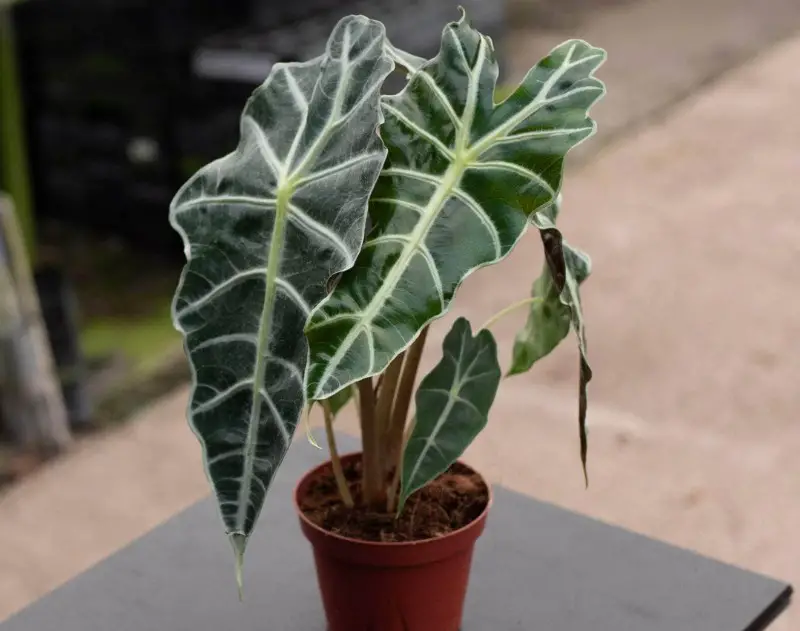Alocasia Polly, also known as the African Mask Plant or Alocasia × amazonica ‘Polly’, is a striking houseplant with bold, arrow-shaped leaves and distinctive veining. Native to the tropical regions of South Asia, this plant has become a favorite among indoor gardeners for its dramatic appearance and relatively low-maintenance care requirements. Alocasia Polly can thrive year-round indoors with the right conditions, making it a perfect plant for both novice and experienced plant enthusiasts.
In this detailed guide, we will cover everything you need to know to successfully grow and care for Alocasia Polly. Whether you’re looking to add a touch of the tropics to your home or need help troubleshooting common plant problems, this guide will provide you with the most comprehensive information on how to nurture your Alocasia Polly into a thriving, beautiful houseplant.
Overview of Alocasia Polly

Before we dive into the specifics of care, let’s start by understanding a few key facts about Alocasia Polly:
- Common Name: Alocasia Polly, African Mask Plant
- Botanical Name: Alocasia × amazonica ‘Polly’
- Family: Araceae
- Plant Type: Bulb
- Mature Size: 1-2 feet tall and wide
- Sun Exposure: Part shade, bright indirect light
- Soil Type: Moist, rich, well-drained
- Soil pH: Acidic
- Bloom Time: Summer
- Flower Color: Pale green, cream
- Native Area: Southern Asia
- Toxicity: Toxic to humans and pets
With this foundational knowledge, let’s move on to the specific care instructions for Alocasia Polly.
Light Requirements for Alocasia Polly
Alocasia Polly thrives in bright, indirect light, which mimics the dappled sunlight it would receive in its natural tropical habitat. An east-facing window is an ideal location, as it provides gentle morning sunlight without the harsh intensity of direct rays. If placing the plant in a south- or west-facing window, use sheer curtains to diffuse the light and prevent sunburn on the leaves.
Tips for Proper Light Exposure:
- Avoid direct sunlight, which can scorch the leaves and cause them to develop brown patches.
- If the leaves appear pale or washed out, it may be a sign that the plant is getting too much light.
- For darker indoor spaces, consider using grow lights to supplement natural light and encourage healthy growth.
Soil Requirements
Alocasia Polly prefers rich, well-draining soil with plenty of organic matter to retain moisture. A standard potting mix for houseplants can be used, but it’s a good idea to mix in perlite or orchid bark to improve aeration and drainage.
Recommended Soil Mixture:
- 2 parts potting soil
- 1 part perlite or pumice
- 1 part orchid bark or coconut coir
This blend ensures that the soil remains moist without becoming waterlogged, which is crucial to prevent root rot.
Watering Your Alocasia Polly
Watering is one of the most critical aspects of caring for Alocasia Polly. This plant enjoys consistently moist soil but is sensitive to overwatering, which can lead to root rot. The goal is to keep the soil evenly moist, but not soggy.
Watering Tips:
- Water when the top inch of soil feels slightly dry.
- Water thoroughly until water drains from the bottom of the pot, then empty the saucer to prevent water from sitting at the roots.
- Reduce watering in the winter months when the plant’s growth slows down. During this period, allow the top of the soil to dry out slightly before watering again.
Temperature and Humidity
As a tropical plant, Alocasia Polly thrives in warm, humid conditions. The ideal temperature range for this plant is between 65-80°F (18-27°C). It is important to keep it away from cold drafts, air conditioners, and temperatures below 60°F (15°C), as cold can damage or even kill the plant.
Humidity Tips:
- Keep humidity levels high by placing the plant in a naturally humid environment, such as a bathroom or kitchen.
- Grouping Alocasia Polly with other humidity-loving plants or using a humidifier can help maintain optimal moisture in the air.
- Misting the leaves occasionally can help, but be careful to avoid over-misting, which can lead to fungal issues.
Fertilizing Alocasia Polly
During the growing season (spring and summer), Alocasia Polly benefits from regular feeding. Use a balanced, water-soluble houseplant fertilizer diluted to half strength every two weeks. This will help encourage healthy growth and vibrant foliage.
Fertilizing Tips:
- Stop fertilizing during the fall and winter months when the plant enters a dormant phase.
- Always water the plant before fertilizing to avoid fertilizer burn.
Pruning Alocasia Polly
Alocasia Polly does not require extensive pruning, as it is relatively slow-growing, especially indoors. However, occasional maintenance pruning can help keep the plant looking tidy and healthy.
Pruning Tips:
- Use sterilized pruning shears to remove any yellow, brown, or damaged leaves at the base of the stem.
- If the plant flowers indoors (which is rare), remove spent flowers to redirect the plant’s energy toward foliage growth.
Propagating Alocasia Polly
Alocasia Polly can be propagated through division, particularly when the plant has become large or rootbound. The best time to propagate is in the spring or summer when the plant is actively growing.
Steps for Propagation by Division:
- Gently remove the plant from its pot and loosen the soil around the root ball.
- Look for small, dormant bulblets or corms that can be separated from the main plant.
- Replant each division in fresh potting soil, ensuring that the soil remains moist.
- Place the newly divided plants in a warm, bright spot with indirect light.
Potting and Repotting
Alocasia Polly should be repotted every two to three years, or when the plant becomes rootbound. A rootbound plant may show signs of poor drainage or slow growth, as the roots outgrow the space available.
Repotting Tips:
- Choose a new pot that is one size larger than the current pot.
- Use fresh, well-draining soil to provide the plant with new nutrients.
- Repot in the spring, when the plant is coming out of its dormant phase.
Overwintering Alocasia Polly
In the winter months, Alocasia Polly may enter a dormant phase, during which it will slow down its growth and may even lose some of its leaves. This is normal and should not be a cause for concern.
Winter Care Tips:
- Keep the plant in a warm environment with temperatures above 65°F.
- Reduce watering but do not let the soil dry out completely.
- Consider using a grow light to extend the daylight hours and prevent leaf drop.
Common Pests and Diseases
Alocasia Polly is prone to common houseplant pests such as spider mites, scale, mealybugs, and aphids. Regularly inspect the leaves for signs of infestation, such as webbing, sticky residue, or small crawling insects.
Pest Management:
- If pests are detected, isolate the affected plant and treat with neem oil or insecticidal soap.
- Wipe down the leaves with a cloth soaked in rubbing alcohol to remove pests.
How to Get Alocasia Polly to Bloom
While it’s rare for Alocasia Polly to bloom indoors, under optimal conditions, it may produce small, pale green or cream-colored flowers. Blooms typically occur during the summer months.
Encouraging Blooms:
- Ensure the plant receives plenty of bright, indirect light.
- Maintain consistent moisture and humidity levels.
- Remove dead flowers promptly to encourage more blooms.
Troubleshooting Common Problems
Even with the best care, you may encounter a few challenges with Alocasia Polly. Here are some common issues and how to address them:
Brown Spots on Leaves
- Cause: Sunburn from direct sunlight.
- Solution: Move the plant to a spot with indirect light.
Yellowing Leaves
- Cause: Overwatering or underwatering.
- Solution: Check the soil moisture and adjust your watering routine.
Drooping or Leaf Loss
- Cause: Temperature fluctuations or dormancy in winter.
- Solution: Keep the plant warm and maintain consistent care.
Conclusion
Alocasia Polly is a beautiful plant that requires little care. It can grow magnificently if given the ideal conditions, which include warm, humid air, steady moisture, and bright, indirect light. It may be kept healthy and lively with periodic pruning, careful watering, and regular feeding.
You can address typical problems like bugs or yellowing leaves by using this instructions, and you can even grow new plants. Your Alocasia Polly will thrive and become a focal point of your plant collection with the correct care.






